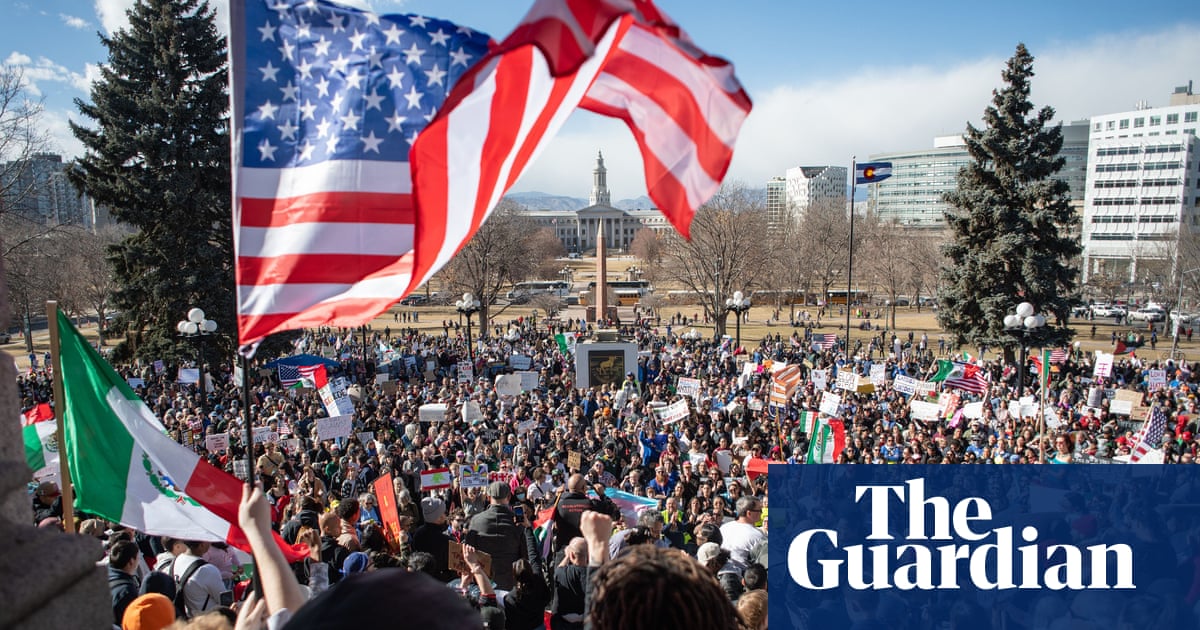Kilmar Abrego Garcia, a 29-year-old man married to a U.S. citizen, sits wrongfully behind bars in El Salvador’s CECOT prison. His story shows how an ICE deportation mistake can turn someone’s life upside down. The U.S. Supreme Court has ruled his removal illegal and ordered the administration to make his return to American soil easier.
The situation has become more complicated. Abrego Garcia landed in El Salvador’s notorious mega-prison in March 2025 without any legal process or hearing. This happened even though he had received a “withholding of removal” order in 2019. The Trump administration paid El Salvador $6 million to house deported prisoners but now says it cannot force the Central American nation to send him back. His case clearly shows how immigration enforcement can go terribly wrong and raises serious questions about U.S. deportation practices.
Trump Administration Deports Abrego Garcia Despite Legal Protections

Image Source: The Guardian
Kilmar Abrego Garcia, a Salvadoran national, lived peacefully in Maryland for 15 years until ICE officers detained him in March 2025. His case now stands at the center of the debate about immigration enforcement overreach.
Who is Kilmar Abrego Garcia?
Abrego Garcia fled political violence in El Salvador in 2011 and created a new life in the United States. He married U.S. citizen Jennifer Vasquez Sura, who says he “dedicated himself to making our family’s American dream come true”. Court records show Abrego Garcia has no criminal record in the United States or El Salvador.
An immigration judge granted him “withholding of removal” in 2019, a legal protection that specifically prevented his deportation to El Salvador. This protection meant the Department of Homeland Security had determined Abrego Garcia wasn’t “a danger to the security of the United States”. The Trump administration later claimed he belonged to MS-13, but his attorneys strongly deny these allegations.
How ICE Violated Court-Ordered Protections
Immigration authorities arrested Abrego Garcia on March 15 and immediately deported him to El Salvador with over 200 other migrants. This action violated his court-ordered withholding of removal protection directly.
Several high-ranking officials admitted the mistake. Solicitor General John Sauer called the deportation an “administrative error”. ICE Assistant Secretary of Public Affairs Tricia McLaughlin told media it was a “clerical error,” adding, “He should have been sent to a detention center in Mexico, Nicaragua, Egypt”.
Legal experts point out that ICE officials ignored required legal procedures. The US government needed to reopen Abrego Garcia’s immigration court proceedings and prove to the judge that he was an MS-13 member to revoke his protections. They deported him without following these steps.
The evidence against Abrego Garcia seems weak – just “his Chicago Bulls hat and hoodie, and a vague, uncorroborated allegation from a confidential informant claiming he belonged to MS-13’s ‘Western’ clique in New York—a place he has never lived”. A federal judge later questioned these allegations’ credibility.
MS-13 Allegations Surface Without Criminal Charges

Image Source: ICE
The Trump administration started making serious allegations about Abrego Garcia’s character and background right after his deportation. Officials used these claims to justify what they called an “error” that led to his removal from the United States.
Administration Officials Claim Gang Membership
Senior White House officials labeled Abrego Garcia as an MS-13 gang member after they deported him. Stephen Miller, a top White House adviser, said no mistake happened during the deportation because Abrego Garcia could be legally removed due to his alleged MS-13 membership. White House Press Secretary Karoline Leavitt made stronger claims: “Abrego Garcia was a foreign terrorist. He is an MS-13 gang member. He was involved in human trafficking”. JD Vance, the Vice President, wrongly called him a “convicted MS-13 gang member”. Secretary of State Marco Rubio had labeled MS-13 as a “foreign terrorist organization” two months before the deportation.
Why No Criminal Charges Were Ever Filed
Abrego Garcia never faced conviction for any crime in the United States or El Salvador. Officials based their gang allegations on flimsy evidence: his Chicago Bulls hat, a hoodie, and an unverified claim from a confidential informant about his membership in MS-13’s “Western” clique in New York—a state where he never lived. The information came through multiple layers of hearsay. Neither the detective making the accusation nor the unnamed informant could face questions from Abrego Garcia’s attorney. The Department of Homeland Security’s decision to grant him withholding of removal status showed they didn’t consider him “a danger to the security of the United States”.
How Gang Allegations Affect Immigration Cases
Gang allegations create serious problems in immigration proceedings across the country. DHS makes immigrants with suspected gang ties their top enforcement priorities, even without criminal convictions. These claims can lead to detention, bond denial, and deportation. Accused immigrants must prove their innocence, yet immigration proceedings don’t follow the same evidence rules as criminal cases. Immigration lawyers say evidence often consists of social media pictures, clothing items, or unconfirmed third-party reports. These vague accusations can destroy asylum claims, DACA status, and other immigration protections.
El Salvador Imprisons Garcia in Notorious CECOT Facility

Image Source: Wikipedia
Kilmar Abrego Garcia ended up in El Salvador’s notorious CECOT (Centro de Confinamiento del Terrorismo) after his deportation on March 15. This mega-prison was built just to house gang members. A senior State Department official confirmed Garcia stays “alive and secure” in the facility. He remains there “pursuant to the sovereign, domestic authority of El Salvador”.
Inside El Salvador’s Terrorism Confinement Center
Salvadoran President Nayib Bukele’s aggressive anti-crime strategy centers around CECOT. The Americas’ largest prison opened in 2023 with room for 40,000 inmates. The facility now holds between 10,000 and 20,000 prisoners.
CECOT’s harsh living conditions serve a purpose. The prison keeps inmates in their cells for 23.5 hours each day, with each cell holding 80 prisoners. Metal bunks come without mattresses, pillows, or sheets. Each cell has just an open toilet and cement basin. The prison denies inmates meat in their meals, books, recreation time, and visits from family or legal counsel.
Human Rights Concerns Mount as Garcia Remains Detained
CECOT’s conditions have alarmed human rights organizations. Amnesty International says Garcia faces “enforced disappearance” since he can’t access legal defense, due process, or contact his family.
Garcia now finds himself stuck in a judicial black hole. Human rights monitors report that CECOT’s detainees face “systematic physical beatings, torture, intentional denial of access to food, water, clothing, health care”. U.S. District Judge James Boasberg acknowledged evidence showing CECOT detainees will likely face “immediate and intentionally life-threatening harm at the hands of state actors”.
The U.S. Supreme Court ordered the government to “aid [Abrego Garcia’s] return” on April 7. Yet El Salvador’s President Bukele stated he won’t release him. Garcia remains caught in a diplomatic standoff between both nations.
Legal Experts Challenge Administration’s Claim of Powerlessness
The legal battle over Kilmar Abrego Garcia’s wrongful deportation has turned into a most important constitutional showdown. Legal experts now challenge the Trump administration’s claim about lacking authority to bring him back from El Salvador.
Can the US Government Secure Garcia’s Return?
The Supreme Court made a unanimous ruling that the administration must aid Abrego Garcia’s release from custody in El Salvador. They stated his case should proceed as if “he had not been improperly sent to El Salvador”. The administration took a limited view of this duty. They said they would just “facilitate his entry” if he showed up at a U.S. port of entry.
U.S. District Judge Paula Xinis called this interpretation inadequate. She pointed out that “to date nothing has been done” to bring him back. The administration claims they “cannot immediately bring him back.” They say diplomatic relations “cannot operate at the speed with which the courts are demanding”.
Previous Cases Where Wrongfully Deported Individuals Were Returned
Courts have ordered deportees to return before. Past administrations created policies that directed the government to “facilitate [an] alien’s return to the United States if the alien’s presence is necessary for continued administrative removal proceedings”. Justice Sonia Sotomayor highlighted this precedent in her supporting opinion.
What Powers Does the Executive Branch Have in Foreign Affairs?
The president has substantial foreign affairs authority under the Constitution. Yet legal experts stress these powers have limits. A constitutional scholar explains, “The periodic tug-of-war between the president and Congress over foreign policy is not a by-product of the Constitution, but rather, one of its core aims”.
The Department of Homeland Security has “broad discretion” in immigration enforcement. This includes power to aid returns through various methods like parole and deferred action. Former INS Commissioner Doris Meissner describes this executive authority as “fairly wide”.
How Courts Can Enforce Compliance with Deportation Rulings
Judge Xinis has stepped up pressure on the administration through several enforcement tools. She ordered officials to give daily updates about efforts to bring Garcia back. She started an “expedited discovery” process that requires government officials to testify under oath. She also let Garcia’s lawyers question up to six administration officials. They can request documents that show “who authorized his initial placement there and who presently authorizes his continued confinement”.
The judge made it clear – she might start contempt proceedings if the administration keeps resisting court orders. During one hearing, she stated firmly: “If I make a finding of contempt it will be based on the record before me”.
Kilmar Abrego Garcia’s case reveals glaring failures in America’s immigration enforcement system. He had legal protections and a clean record, yet he sits in El Salvador’s notorious CECOT prison due to ICE’s admitted administrative mistake. The Trump administration made MS-13 allegations that rested on weak evidence – a Chicago Bulls hat and unverified informant statements. These actions raise serious concerns about deportation practices and accountability.
Life in CECOT has become unbearable for Garcia. Prisoners spend 23.5 hours each day in confinement without simple amenities or legal help. The Supreme Court’s unanimous decision demands Garcia’s return to the U.S., which has created tension between judicial power and the executive branch’s claims about diplomatic constraints.
Garcia’s case exposes dangerous gaps in immigration enforcement oversight. His story shows how protected legal status can vanish when enforcement systems fail to provide due process. The current impasse between U.S. courts and El Salvador’s government leaves Garcia’s future uncertain, and the human cost of such administrative errors continues to mount.






